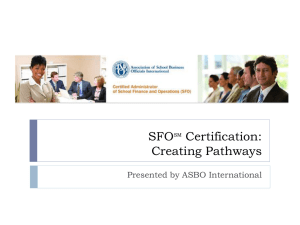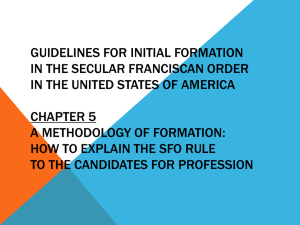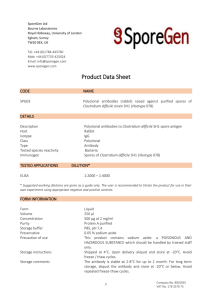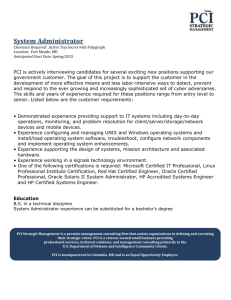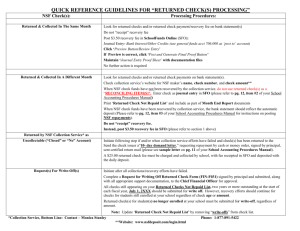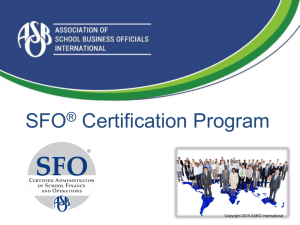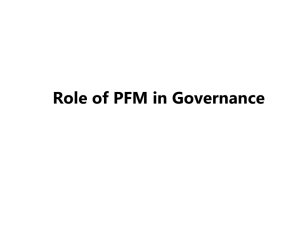Certified Administrator of School Finance and Operations
advertisement
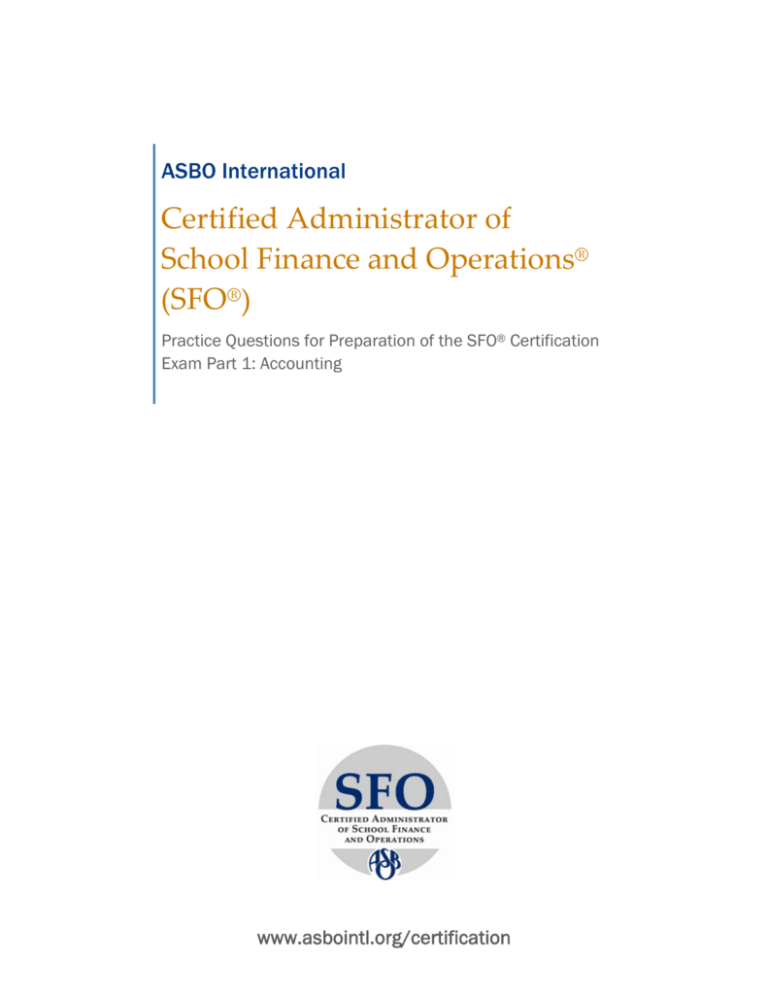
ASBO International Certified Administrator of School Finance and Operations® (SFO®) Practice Questions for Preparation of the SFO® Certification Exam Part 1: Accounting www.asbointl.org/certification ASBO International Certified Administrator of School Finance and Operations® (SFO®) PRACTICE Q UESTIONS PART 1: ACCOUNTING Practice Questions for Preparation of the SFO Certification Exam Part 1: Accounting The questions presented are practice questions for the Part 1: Accounting exam of the Certified Administrator of School Finance and Operations (SFO) certification program. They do not represent the exam content to its exact percentages of the domains presented in the exam content outline. These were created as a more extensive set of questions to use in assisting candidates in the preparation of the exam. Answers to these practice questions can be found on the page 7. Context of the Part 1: Accounting Exam The Part 1: Accounting exam of the SFO Certification is written from the perspective of the professional who may or may not have any years of experience in school business management. The knowledge and skills covered in this exam represent what this professional should know at the time he or she is first hired for a position in school business management. The domains and content areas covered on this exam are as follows (percentage of the exam is provided in parentheses): Manage Accounting Systems (28% to 33%) Maintain Accounting Software Maintain Chart of Accounts Reconcile General Ledger Accounts Track Fixed Assets Manage Accounting Functions (67% to 72%) Manage Payroll Functions Manage Accounts Receivable Manage Accounts Payable Process Manage Purchasing Procedures Manage Annual Budgets Prepare Financial Reports Manage Cash Flow There are 70 multiple-choice items in total for this exam, with an allotment of 2 hours in which to take it at the Pearson VUE testing center near you. Canadian equivalents are provided in [] within each question as needed to provide clarification. For more information about the exam and the SFO program, visit www.asbointl.org/certification 1 ASBO International Certified Administrator of School Finance and Operations® (SFO®) PRACTICE Q UESTIONS PART 1: ACCOUNTING Practice Questions for Part 1: Accounting Exam of the SFO Certification 1. What information is required to process an accounts payable invoice for payment? A. Verified budget authority for item, accuracy of price, items received, and correct account code B. Accuracy with purchase order price, amount ordered, and correct account code C. Verified receipt of goods, price charged, and correct account code D. Authorization to pay, goods received, accurate pricing, and correct account code 2. What strong internal control assures that only authorized employees are paid on a payroll? A. Review of the payroll register by the supervisor of the payroll processing clerk B. Written documentation from an authorized person other than the person processing the payroll C. Approval of the payroll register after comparing it to the established staff list D. Review of the payroll register by the school board chair 3. What is the purpose of a requisition system? A. To acquire goods and services by purchase order and verify budget authority B. To purchase goods and services through a formal bid [tendering] process and follow legal compliance regulations C. To manage the compliance of purchasing goods and services for the different departments within the school district D. To verify all purchases are completed within the parameters of the budget and meet the bid [tender] process laws 4. What primary factor should be considered when disposing of fixed assets? A. The item is of no further use in its current location B. There is an updated version of the item from the current vendor C. The item has exceeded its useful life and is of no further use to the school district D. A similar version of the item is available from another vendor 2 ASBO International Certified Administrator of School Finance and Operations® (SFO®) PRACTICE Q UESTIONS PART 1: ACCOUNTING 5. What factors should be considered in managing the budget for the year? A. Compare current year's revenues and expenditures to a 10-year average for consistency B. Compare estimated revenues and expenditures to projected actual revenue and expenditures for the year C. Compare current year's revenues and expenditures to last year’s to determine if the budget is on track D. Compare current year's budget to other school district budgets in the state [province] to check for consistency 6. What is an example of a "proprietary fund"? A. A trust fund B. A general fund C. A capital projects fund D. An enterprise fund 7. What information should be provided in a financial report so the governing body can determine the local education agency's [authority’s] financial position? A. A comparison of budget to actual revenues and expenditures and fund balance B. A comparison of current year budget to prior year budget C. A comparison of expenditures that have been approved by the school board D. A comprehensive comparison of revenues and expenditures for the current year 8. What procedure should be in place for collection of unpaid accounts? A. Prepare an aging list by customer and send letters, email, or call regarding collection on past due accounts B. Immediately refuse any future services until the bill is paid C. Prepare an aging list by customer and publish it in the local newspaper D. Keep the invoices on the books and wait for payment 3 ASBO International Certified Administrator of School Finance and Operations® (SFO®) PRACTICE Q UESTIONS PART 1: ACCOUNTING 9. What represents the strongest control for processing payments? A. An accounting employee pays from original invoices only, not from copies of invoices B. Transactions are handled by the same employee from initiation to authorization C. An accounting employee maintains a list of sequential check numbers to ensure all checks are accounted for D. The employee who authorizes the transaction is not the same employee who initiated the transaction 10. What is an important consideration when developing a data recovery backup plan? A. The backup information will be securely stored on a separate server in the same location with the capability to run the software B. The backup information will be securely stored in an offsite location with the capability to run the software at an alternate location C. The backup information will be securely stored and accessible only to individuals who have the technical knowledge to run the software D. The backup information will be securely stored and accessible to a third-party vendor who has the technical knowledge to run the software 11. What activities affect cash flow? A. Investing and timing of receipts B. Budgeting and timing of receipts C. Depreciation of assets and investing D. Financing and depreciation of assets 12. To assure proper internal controls when processing timesheets for payment, what information is needed in addition to time worked and rate of pay? A. Budget authority, amount approved, and employee signature B. Account code, description of work completed, and employee signature C. Supervisor approval, employee signature, and account code D. Budget authority, source of funds, and account code 4 ASBO International Certified Administrator of School Finance and Operations® (SFO®) PRACTICE Q UESTIONS PART 1: ACCOUNTING 13. Request for Proposals (RFP) must include which of the following items? A. Payment terms B. Project budget C. Proposal due date D. Manufacturer and brand 14. What is necessary to ensure that a public bid [tendering] process is successful and provides the desired goods or services? A. Ensure that appropriate vendors receive notice of the bid [tender] request B. Require an independent legal review of the bid specification documents prior to the bid [tender] release C. Ensure that the bid [tender] opening is performed in public with all bidders present during the opening D. Develop a comprehensive bid [tender] specification and establish a fair rating system to evaluate bids received 15. How should a budget be monitored throughout the fiscal year? A. By ensuring that the balance sheet accounts are in balance B. By reviewing for variances in the revenue and expenditure accounts C. By comparing current year activity to prior year activity D. By accumulating the necessary data to prepare a trial balance 16. In an organization with no central purchasing function, who should be responsible for general ledger coding of purchase requisitions? A. The individual who is responsible for paying the invoice B. The individual who is responsible for receiving the merchandise C. The individual responsible for managing the specific budget being accessed D. The individual consuming the merchandise 5 ASBO International Certified Administrator of School Finance and Operations® (SFO®) PRACTICE Q UESTIONS PART 1: ACCOUNTING 17. What accounts appear on a balance sheet? A. Income, assets, and liabilities B. Assets, liabilities, and equity C. Income, expenses, and equity D. Assets, expenses, and equity 18. What information does the Management's Discussion and Analysis (MD&A) provide? A. A statement that compares current-year revenues received with expenditures for the same time period on a fund-by-fund basis B. A management report including all financial transactions on an accrual basis accounting C. A narrative introduction and overview to the annual financial statements prepared by school district personnel D. An opinion of the auditor as to the viability of the school district 19. What is an example of an accounts receivable for a school district using modified accrual basis accounting? A. Student activity receipts B. School fees for the next school year C. An unpaid invoice D. School fees for the current school year 6 ASBO International Certified Administrator of School Finance and Operations® (SFO®) PRACTICE Q UESTIONS PART 1: ACCOUNTING Answers to the SFO Exam Part 1: Accounting Practice Questions: 1. D 2. B 3. A 4. C 5. B 6. D 7. A 8. A 9. D 10. B 11. A 12. C 13. C 14. D 15. B 16. C 17. B 18. C 19. D 7
